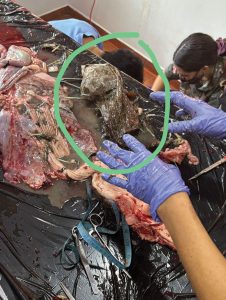Preserving Our Ecosystems: A Case of a Stranded Caiman
 On October 1st, we received an urgent call from SINAC, informing us that the fire department had discovered a caiman exhibiting neurological symptoms, stranded near a river ravine. A trained team promptly immobilized and transported the animal, as only qualified professionals authorized by the government should handle these creatures, ensuring the safety of both the animals and humans involved.
On October 1st, we received an urgent call from SINAC, informing us that the fire department had discovered a caiman exhibiting neurological symptoms, stranded near a river ravine. A trained team promptly immobilized and transported the animal, as only qualified professionals authorized by the government should handle these creatures, ensuring the safety of both the animals and humans involved.
 Upon arrival, we sedated the caiman, later identified as a Caiman crocodilus, one of the native caiman species found in southern and central Pacific Costa Rica, as well as the Atlantic region. Our examination revealed a significant head wound, likely the cause of his neurological symptoms. In addition, one of his eyes appeared irritated, so we applied an eyepatch for protection. We treated his wounds, collected samples for analysis, and administered hydration through subcutaneous fluids to support his recovery.
Upon arrival, we sedated the caiman, later identified as a Caiman crocodilus, one of the native caiman species found in southern and central Pacific Costa Rica, as well as the Atlantic region. Our examination revealed a significant head wound, likely the cause of his neurological symptoms. In addition, one of his eyes appeared irritated, so we applied an eyepatch for protection. We treated his wounds, collected samples for analysis, and administered hydration through subcutaneous fluids to support his recovery.
 We then prepared a secure enclosure for the caiman to facilitate his recovery and ongoing treatment. Unfortunately, despite our efforts, he succumbed to his severe head injury just a day later. We were grateful for the opportunity to perform a necropsy, which allowed us to learn valuable insights into the anatomy of these remarkable animals. For instance, we discovered their tough skin and noted how their eyes and nostrils are positioned on top of their heads, enabling them to see and breathe while the rest of their bodies remain submerged.
We then prepared a secure enclosure for the caiman to facilitate his recovery and ongoing treatment. Unfortunately, despite our efforts, he succumbed to his severe head injury just a day later. We were grateful for the opportunity to perform a necropsy, which allowed us to learn valuable insights into the anatomy of these remarkable animals. For instance, we discovered their tough skin and noted how their eyes and nostrils are positioned on top of their heads, enabling them to see and breathe while the rest of their bodies remain submerged.
During the necropsy, we made a concerning discovery: a trash bag lodged in the caiman’s stomach. This finding underscores the critical need for proper waste disposal and environmental stewardship. Caimans play a vital role in their ecosystems; if their populations decline due to human activities, we risk upsetting the balance of local habitats. The reduction of predator species can lead to unchecked herbivore populations, which can devastate plant life and harm other wildlife.
 Historically, caimans have faced exploitation by humans for their skin, perceived aggression, and medicinal uses. Additionally, urban expansion has significantly shrunk their natural habitats, leading to increased habitat fragmentation. It’s important to recognize that in nature, various species such as birds, foxes, and felines help control caiman populations by preying on their eggs.
Historically, caimans have faced exploitation by humans for their skin, perceived aggression, and medicinal uses. Additionally, urban expansion has significantly shrunk their natural habitats, leading to increased habitat fragmentation. It’s important to recognize that in nature, various species such as birds, foxes, and felines help control caiman populations by preying on their eggs.
In light of this, we must strive to respect the balance of ecosystems and minimize our interactions with wildlife in general. By understanding and protecting these incredible creatures, we contribute to the preservation of our environment for future generations.
